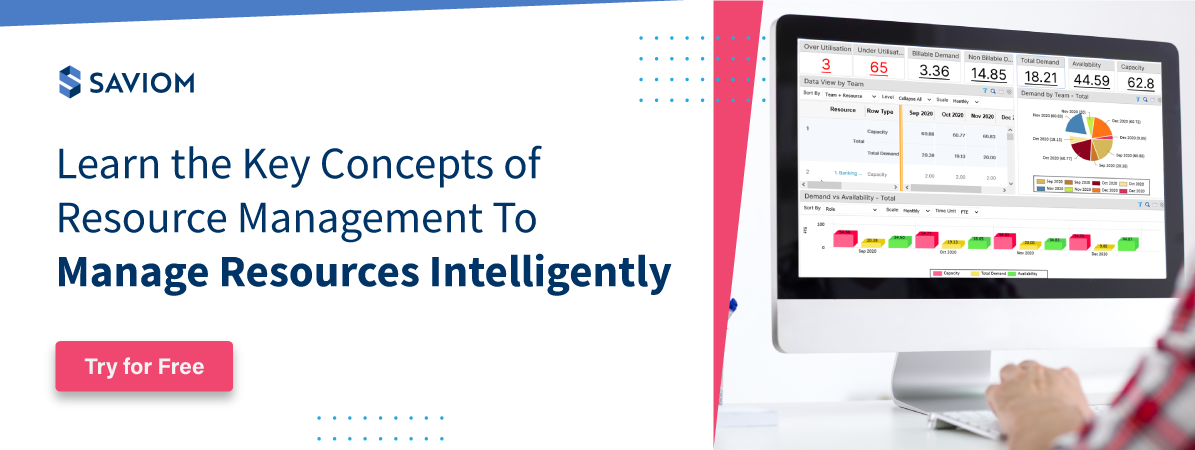Utilizing every resource intelligently is imperative for every organization as they are the most high-priced investments of any business. Moreover, organizations spend a lot of time and cost in creating the right talent pool. Therefore, when their skills and competencies are tapped to their maximum potential, it enhances overall efficiency and profitability.
Resource management has become an integral part of any business today. It has emerged as an independent discipline after organizations became complex with matrix structure and expanded in multiple geographies.
Efficient project resource management provides centralized data into a single repository and provides a single version of the truth.
Its components include resource scheduling, resource forecasting & planning, capacity planning, business intelligence/reporting, integration with other related applications, and more.
This blog explains all its necessary concepts and aims to steer you through a successful journey as a resource manager.
Let’s begin with what is resource management,
1. Definition of Resource Management
Resource Management is the process of utilizing various types of business resources efficiently and effectively. These resources can be human resources, assets, facilities, equipment, and more.
It refers to the planning, scheduling, and future allocation of resources to the right project at the right time and cost.
Resource management plan enables businesses to utilize the skilled workforce and improve profitability optimally.
2. Importance of Resource Management
Resource management plays a significant role in improving a business’s profitability and sustainability. Let’s highlight how enterprise resource management can help in contributing to both the top line and bottom line of any business.
1. Minimize project resource costs significantly
According to Deloitte, “Cost reduction takes precedence over other business initiatives.”
With enterprise-wide visibility, resource managers can utilize cost-effective global resources from low-cost locations. Having the right mix of local and global resources helps in reducing project costs. Allocating the right resource for the right project enables them to complete the delivery within time and budget. Resource managers can control costs by distributing key resources uniformly across all projects instead of a high-priority project.
2. Improving effective/billable resource utilization
Resource management software helps managers forecast the workforce’s utilization in advance. Accordingly, resources can be mobilized from non-billable to billable and strategic work. Sometimes when resources are rolled off from projects, there isn’t any suitable work to engage them. So, eventually, these resources end up on the bench. Resource managers can initially engage these resources in non-billable work before quickly assigning them to suitable billable/strategic projects
3. Bridge the capacity vs. demand gap proactively
Demand forecasting, a function of project resource management, allows managers to foresee the resource demand ahead of time. It enables them to assess and analyze the skills gap within the existing capacity. After identifying the shortages and excesses, resource managers can formulate an action plan to proactively bridge the capacity vs demand gap proactively.
4. Use scarce resources effectively in a matrix organization
The resource management process brings transparency in communication and hence facilitates to effectively share highly skilled resources in a matrix organization. The scarce resources can be utilized across different projects rather than one high-priority project. The shared services model will also form teams cutting across multiple geographies for 24 * 7 support operations.
5. Monitor and improve organization health index
Employees look up to their leaders for their professional development. Failing to motivate and provide career development opportunities will predominantly lead to reduced engagement, productivity, and unplanned attrition. Regular monitoring of their skills and performances is beneficial to help them improve and add more value to the organization.
Let’s dive deep into the major components and concepts of resource management,
3. Resource Management Concepts & its Components
1. Resource scheduling
Resource scheduling involves identifying and allocating resources for a specific period to different project tasks. These tasks can be anything from billable, non-billable, or BAU work.
With a centralized Gantt chart view of the enterprise, resource scheduling eliminates silos of spreadsheets. It also facilitates you to deploy the competent resources to the right job to finish the project within budget and time.
2. Resource utilization
Resource utilization measures the amount of time spent by the employees on different project tasks against their availability. It is a key performance indicator in the modern business landscape as it directly influences the firm’s bottom line.
Utilization can be measured in terms of :
- Overall resource utilization
- Billable utilization
- Strategic utilization
- Non-billable utilization
Resource Managers can proactively mobilize resources from non-billable to billable/ strategic tasks and maximize their billable utilization.
3. Resource forecasting
Resource forecasting helps managers predict resource utilization levels in advance and foresee the resources likely to end up on the bench. In addition to these, they can also stay forewarned of the required capacity for pipeline projects.
Leveraging this information, one can
- Mobilize the resources to billable tasks from non-billable or BAU activities.
- Ensure effective bench management
- Bridge the capacity and demand gap
4. Resource and capacity planning
Resource planning is the comprehensive process of planning, forecasting, allocating, and utilizing the workforce most efficiently and intelligently. Resource capacity planning is an undertaking to analyze and bridge the capacity and demand gap well ahead of the curve.
These two components are vital to ensure that none of the project vacancies go unfilled or excess capacity gets wasted. Simply put, resource and capacity planning maximize optimal utilization and timely project deliveries.
5. Business intelligence and reports
Business intelligence provides actionable insights by performing extensive data analysis. Using real-time data, individualized reports, and dashboards on important resource management metrics are generated. These reports strengthen the managers’ decision-making abilities and allow them to monitor the overall resource health index.
Now that we are aware of the significant components and resource management concepts. Let’s understand what skills can help a manager ace this multi-layered process,
4. Resource management skills that every manager should have
Resource managers have multiple responsibilities to account for when managing the most significant investment of the firm. From understanding the talent pool to being the key link between PMOs and the workforce, they have a lot on their to-do list.
Here’s a list of must-have skills for a manager to streamline this complex process:
1. Communication skills
Resource managers are accountable for fulfilling resource requests from project managers by assigning the job to the right resource. Since they act as mediators in this process, it’s imperative to have exemplary communication skills. It will enable them to explain the roles and responsibilities to the resources better while also making reasoning with the project managers seamless.
2. Conflict resolution
Often multiple project managers end up requesting similar-skilled resources. In this case, if the project prioritization criteria are not in place, it may lead to conflicts. Also, a lack of transparency in defining goals and objectives can lead to resources being clueless, which can also result in discrepancies. It’s the job of a resource manager to intervene, set the expectations right, and ensure that everyone is on the same page to keep the work going. This is why conflict resolution skill is a mandate.
3. Domain knowledge
Since the onus is on resource managers to allocate the right resource to the right job, it’s important that they understand the skillset very well. If a resource manager with no engineering knowledge is working for an engineering firm, it will put forth resource planning challenges in the long run. For this, they must have domain expertise to get more clarity.
4. Proactive planning
Every project manager aims to complete the project within time and budget, which makes forward planning a critical aspect. Since success highly relies on the workforce, resource managers need to be extremely proactive to fulfill the demand. They should be quick-witted to make calculated decisions about implementing the right resourcing treatments.
5. Negotiation skills
Resource planning is a complex job and brings forward a myriad of challenges for the resource manager. For example, a project manager has requested an employee with advanced-level technical skills. If one skill is missing and it’s expensive to hire another resource, managers have to convince the project owners. In such cases, managers must be able to negotiate well and get the job done.
6. Risk management
What if a resource takes prolonged unplanned leaves? What happens if there is unplanned attrition? A running project can come to a halt. How would a resource manager tackle this situation? If they have a backup plan in place, these situations will seem easy to deal with. Risks are inevitable in the project landscape. Thus, resource managers should hone their risk management skills with forward planning to keep the project going.
These are some of the imperative skills for a resource manager. Let’s now understand what kinds of businesses require resource management.
5. Types of Businesses that Require Enterprise Resource Management?
Organizations with a matrix-based set-up, cross-functional teams, and a shared-services model require enterprise resource management. The level of complexity to which they adopt the business processes depends on their size and functions. Today resource management is part of every organization’s DNA.
Industries such as IT services, construction & engineering, audit & accounting, and professional services organizations, etc. have implemented robust resource management processes.
Other crucial factors that constitute the need for resource management are firms working on multiple projects in ad-hoc environments. It means that they are exposed to several changing variables like project priorities, resource availabilities, and budget constraints.
These complexities demand enterprise-wide visibility and real-time updates to help the managers stay informed at all times. They need to manage their resources diligently and finish the projects within budget and time. Therefore, organizations need to invest in resource management solutions for effectively utilizing their resources irrespective of the industry type.
Formulating a resource management framework is only half the battle won. It is equally important to implement this strategy using an appropriate resource management tool to suit organizational needs. Otherwise, poor resource management will have an adverse effect on the entire resource pool and the firm’s reputation.

Here are some of the consequences,
6. Consequences of Poor Resource Management Strategy
1. Increased project costs
Incompetent allocation or booking high-cost resources instead of the low-cost but similarly skilled workforce spikes project budget. Since the resources’ skills and competencies are not leveraged most effectively, project costs will increase, causing unnecessary budget overruns.
2. Reduced employee performance
Poor employee performance is the first and foremost indicator of sub-optimal resource management. Unrealistic expectations, over-allocations, or bookings without considering employee interests and skills can contribute to reduced engagement and productivity. It will adversely affect the project’s quality and lower down employee morale.
3. High employee turnover
Employees feel disengaged and dissatisfied when their strengths and skills are not exploited at their best. Over-utilization due to unrealistic deadlines can lead to employee burnout. These circumstances can compel your valued talent pool to look for opportunities elsewhere, which will gradually increase employee turnover.
4. Delays in meeting project deadlines
Without visibility of team members and their skill set, resources may get allocated to projects that do not match their competencies. It can result in delivery delays as significant time will be spent to learn on the job before becoming productive. Delays in meeting deadlines also blow up project costs.
5. Client dissatisfaction and loss of business
Inefficient resource management practices lead to poor resource allocation, which causes teams to put in longer hours for meeting project goals. Tight deadlines and a heavy workload can put the team under pressure, thereby increasing the likelihood of errors. Delayed delivery, compromised quality, and budget spike jeopardize project health resulting in client dissatisfaction and eventually business loss.
The decision-makers must therefore formulate an efficient resource management plan to avoid facing these consequences. Managers can formulate this plan using advanced resource management software.
7. Resource Management trends to look forward to
The emergence of innovative and advanced technology has created a paradigm shift in the ways resources are managed. Modern tools are developed using Business Intelligence that provides precise insights into resource metrics and promotes data-driven decisions.
Here is the list of trends you will witness in the near future:
1. Going beyond simple scheduling and planning tools
Most of the resource managers implement basic scheduling and planning tools to allocate tasks to resources. However, as mentioned earlier, resource management goes beyond these concepts and covers a lot more. Thus, firms will soon start investing in a holistic tool that maintains a single version of the truth across the enterprise and provides all features under one roof.
2. Replacing guesstimations with real-time forecasting to plan future projects
Resource managers still deploy resourcing treatments based on mere assumptions and guesstimations. A modern tool will replace that with real-time forecasting. Managers will get precise foresight into project resource demands, resource availability, utilization, and more.
3. Using Business Intelligence to derive reports and maximize utilization
Modern software is integrated with business intelligence that derives information from the data and provides intuitive reports in real-time. Managers can use these reports to their advantage to assess and improve various metrics. For instance, they can maximize productive utilization of the workforce, which will enhance their productivity.
4. Switching from emails to a well-formulated resource requisition workflow
Project and resource managers still send endless trails of emails to get the required resources. Resource management software will change this by helping you form a resource requisition workflow. The first-come, first-serve basis will become obsolete, and priority projects will take precedence. Moreover, it will form an audit trail that will give absolute transparency to the stakeholders and management.
5. Implementing modeling & simulation to form the best-fit resource plan
Creating a resource plan involves a lot of analysis to eliminate potential bottlenecks in the future. An advanced tool brings a compelling feature ‘what-if analysis’ into the picture. Resource managers can leverage it to simulate different variables, form the best-fit resource plan and mitigate against the potential risks.
6. Empowering employees to choose their areas of interest
Businesses have restructured to become employee-centric which helps them grow professionally while the project needs are taken care of. To stay one step ahead, managers can now create an open seat for relevant project positions and allow employees to choose their areas of interest. It will enable them to diversify their portfolio, hone their skills, and escalate productivity.
7. Introducing a well-defined out-rotation policy for employee retention
When a critical resource is working on one project, managers tend to deploy the same resource to similar projects in the future. It creates a limitation for the employees as they don’t get to work on multi-faceted projects. Thus, resource managers must formulate a well-defined out-rotation policy that will provide fair chances to every employee to polish their expertise.
These are some of the resource management trends that will facilitate managers to unleash the maximum potential of their workforce and maintain a competitive edge.
8. Over to you
It is now evident that resource management is crucial for the success of any business. Resource management is not a ‘one size fits all’ process. Every organization operates differently and therefore needs a tailored resource management plan that suits their needs.
The concepts mentioned above and tips will help you formulate the right resource management strategy for your firm.
What process do you follow to ensure efficient management of resources?
9. The Glossary
10. The Saviom Solution
SAVIOM is the market leader for more than 20 years in providing efficient and configurable solutions for managing the workforce. It has been deployed by many Fortune 500 companies across the globe. SAVIOM also provides tools for project portfolio management, professional service automation, and workforce planning software. Contact us for a free trial and we will provide a customized solution to solve all your project resource related challenges.




















